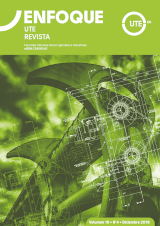Implementation of a Wireless Sensor Network for Electric Light Bulb Management Using IPv6
DOI:
https://doi.org/10.29019/enfoque.v10n4.553Keywords:
Domotics, WSN, 6LoWPAN, TinyOS, IEEE 802 15.4.5Abstract
In this study the results of the implementation of the wireless sensor network prototype, to manage the luminaires in homes are presented, using Iris sensors nodes, designed to work with battery for long periods of time and with limited processing capabilities. The nodes use 6LoWPAN addresses. The address conversion to IPv6 is done by a gateway. The luminaires are managed using devices connected to IPv6 network, with Android operating system. The correct functioning of the prototype is demonstrated by validating the functionalities of the management system implemented.
Downloads
References
Aravindh, J. y Srevarshan, B. (2017). Home Automation in IoT Using 6LowPAN. Advanced Computational Engineering and Networking, 26-28.
Ardiansyah, E.; Seungkyo, O., y Fahmi, A. (2013). Battery-Less 6LoWPAN-Based Wireless Home Automation by Use of Energy Harvesting. International Journal of Distributed Sensor Networks.
Domínguez, F.; Touhafi, A., y Tiete, J. (2012). Coexistence with WiFi for a Home Automation ZigBee Product. 19th Symposium on Communications and Vehicular Technology in the Benelux (SCVT), 1-6. Eindhoven: IEEE.
Han, N.; Wu, Y, y Tang, Y. (2010). Research of KNX Device Node and Development Based on the Bus Interface Module. 29th Chinese Control Conference (CCC), 4346-4350.
Hoang, D. y Sindhu, S. (2016). A Wireless Sensor and Actuator Network (WSAN) Framework for Personalized Thermal Comfort in Office Buildings. International Conference on Sustainable Energy Technologies. Vietnam: IEEE.
Huang, L.; Xiao, L.; Liu, J., et al. (2016). LED Intelligent Lighting System Based on 6LoWPAN. International Conference on Computer Science & Education. Nagoya: IEEE.
Huang, Z. y Yuan, F. (2015). Implementation of 6LoWPAN and Its Application in Smart Lighting. Journal of Computer and Communications, 3, 80-85.
IEEE. (2011). Part 15.4: Low-Rate Wireless Personal Area. New York: IEEE Computer Society.
MEMSIC. (2010). Powerful Sensing Solutions. MEMSIC. Recuperado de http://www.memsic.com/userfiles/files/datasheets/wsn/6020-0091-04_a_mib520cb-t.pdf
MEMSIC. (2012). Document Part Number: 6020-0124-01 Rev A. MEMSIC. Recuperado de www.mensic.com: http://www.memsic.com/userfiles/files/Datasheets/WSN/ IRIS_ Datasheet.pdf
Park, T., y Hong, S. (2010). A New Proposal of Network Management System for BACnet and Its Reference Model. 8th IEEE International Conference on Industrial Informatics (INDIN), 28-33. Osaka: IEEE.
Perandones, M. (2014). Energy-saving Smart Street Lighting System based on 6LoWPAN. Proceedings of the First International Conference on IoT in Urban Space, 93-95
Rand, P. (2018). Wireless Lighting Control: The Bright Road Ahead. , Strategic marketing. Recuperado de https://m.eet.com/media/1118195/ ti%20paper.pdf
Sicos K.. (2013). MSGReader. GitHub. Obtenido de https://github.com/ Sicos1977/ MSGReader
Sikder, A.; Acar, A., y Aksu, H. (2018). IoT-enabled Smart Lighting Systems for Smart Cities. 8th Annual Computing and Communication Workshop and Conference. Las Vegas: IEEE.
Singh, M. (2016). Wireless Sensor Networks: A Survey. Journal of Scientific & Engineering Research, 7(4), 710-716.
Sohraby, K.; Minoli, D., y Znati, T. (2007). Wireless Sensor Networks, Technology, Protocols, and Applications. New Jersey, Estados Unidos: John Wiley & Sons.
Son, H. y Quyet, C. (2015). Design, Implementation, and Evaluation of 6LoWPAN for Home and Building Automation in the Internet of Things. 12th ACS/IEEE International Conference on Computer Systems and Applications. Morocco: IEEE.
TinyOS. (2009). BaseStation. GitHub. Recuperado el de github: https://github.com/tinyos/tinyos-main/tree/master/apps/BaseStation
TinyOS. (2010).Mote PC serial communication and SerialForwarder. TinyOs-Stanford http://tinyos.stanford.edu. Recuperado el de http://tinyos.stanford.edu/tinyos-wiki/index.php/Mote_PC_serial_communication_and_SerialForwarder_(TOS_2.1.1_and_later
Wohlers, I.; Andonov, R., y Gunnar, K. (2013). DALIX: Optimal DALI Protein Structure Alignment. IEEE/ACM Transactions on Computational Biology and Bioinformatics, 10(1), 26-36.
Zhang, Q. y Li, P. (2017). Design and Implementation of an Intelligent Street Lamp Network Node Based on 6LoWPAN Technology. International Conference on Computer, Electronics and Communication Engineering. Sanya: IEEE.
Published
How to Cite
Issue
Section
License
Copyright (c) 2019 Enfoque UTE

This work is licensed under a Creative Commons Attribution 3.0 Unported License.
The articles and research published by the UTE University are carried out under the Open Access regime in electronic format. This means that all content is freely available without charge to the user or his/her institution. Users are allowed to read, download, copy, distribute, print, search, or link to the full texts of the articles, or use them for any other lawful purpose, without asking prior permission from the publisher or the author. This is in accordance with the BOAI definition of open access. By submitting an article to any of the scientific journals of the UTE University, the author or authors accept these conditions.
The UTE applies the Creative Commons Attribution (CC-BY) license to articles in its scientific journals. Under this open access license, as an author you agree that anyone may reuse your article in whole or in part for any purpose, free of charge, including commercial purposes. Anyone can copy, distribute or reuse the content as long as the author and original source are correctly cited. This facilitates freedom of reuse and also ensures that content can be extracted without barriers for research needs.
This work is licensed under a Creative Commons Attribution 3.0 International (CC BY 3.0).
The Enfoque UTE journal guarantees and declares that authors always retain all copyrights and full publishing rights without restrictions [© The Author(s)]. Acknowledgment (BY): Any exploitation of the work is allowed, including a commercial purpose, as well as the creation of derivative works, the distribution of which is also allowed without any restriction.























 Enfoque UTE - Facultad de Ciencias de la Ingeniería e Industrias - Universidad UTE
Enfoque UTE - Facultad de Ciencias de la Ingeniería e Industrias - Universidad UTE